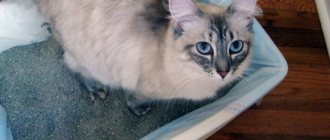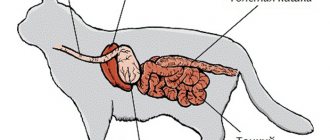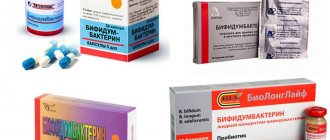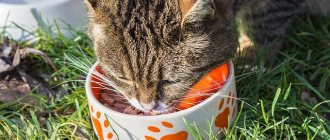Why is this happening?
The causes of vomiting in cats are divided into the following::
- Fasting . If your pet eats less than twice a day, bile may be released in the blood in the morning when the animal is hungry. However, the presence of blood in the vomit does not depend on this.
- Binge eating . Animals suffering from obesity eat a lot and, during prolonged fasting, eat everything in a row. Poorly chewed dry food can damage the walls of the stomach, which is what leads to the scarlet color of the vomit.
- Hormonal disorders . This reason is most common in pregnant cats, when the walls of the uterus are stretched and hormonal levels are disrupted.
- Trauma . If the cat's blood predominates over bile, we are talking about a stomach injury, which may be accompanied by heavy blood loss.
It is important to understand that if a pet vomits, this is a normal process. In medicine there is such a thing as cleansing vomiting, which cleanses the stomach. But, if your cat is vomiting blood, you should contact a specialist and undergo an examination.
Causes of vomiting in cats
There is no single reason for vomiting in cats: it can be a one-time overeating, or the presence of parasites in the body. Vomiting can occur during estrus, in a nursing cat, or in a small kitten. In any case, even a one-time occurrence requires the attention of the owner. Causes include disease, starvation, poisoning and pregnancy in the cat. The closest attention should be paid to repeated vomiting.
global $ads_google; //data-ad-slot=”2475549904″ $ads_google = empty($ads_google) ? false : true; ?> if ($ads_google == false) {?> $ads_google = true; ?> } ?>
Diseases
Here is a list of diseases that can cause a cat to burp regularly:
- chronic renal failure. Often with chronic renal failure in the morning, the ejected contents consist of empty saliva, and uremic syndrome manifests itself;
- gastroenteritis, gastritis - mucus may be visible;
- infectious diseases - the color of the vomit will be greenish;
- obstruction of the pylorus of the stomach - the animal burps white foam;
- tumors;
- parasitic infestations - the cat vomits mucus;
- inflammatory processes in the gastrointestinal tract;
- pancreatitis;
- peritonitis;
- liver diseases.
More details about the reasons will be shown by the color of the contents and accompanying symptoms. If the problem is not poisoning or a swallowed hairball, then diarrhea, constipation, swelling, and lethargic behavior of the pet may appear.
To visit a doctor, it is better to prepare information about the consistency of the vomit, its color, start time, frequency, contents of the last meals, and your pet’s behavior after regurgitation.
Vomiting fur
Sometimes a cat, for no apparent reason, spews out a ball of fur covered in drool and foam. This is a natural process of cleansing the cat’s body from hairs of fur that have entered the stomach. The wool is not digested, but clumps into clumps that cannot enter the intestines. As a result of the accumulation of hair, a special brain center begins its work, signaling the body to begin the vomiting process. Otherwise, the so-called pilobesoar - a ball of hairs huddled together in a bunch - can clog the digestive tract.
Fasting or overeating
Causes
An empty stomach can also cause stomach contents to spill out. A cat is a small predator, which is prescribed by nature to eat little and often. If a pet is starving and sees food 1-2 times a day in large volumes, or even less often, it is likely that periodic vomiting will be present in its life. A small amount of vomit will contain foam and mucous gastric secretions. The urge to vomit on an empty stomach stops immediately after access to food.
The second reason will be the opposite side of eating - overeating. Problems can happen with a full stomach, just like with an empty one. A full stomach puts pressure on the diaphragm, and the body seeks to alleviate this condition by activating the gag reflex. The mass will contain undigested pieces of food.
Treatment
In the first case, the pet’s diet is changed, making the breaks between meals shorter and the portions smaller. When overeating, the frequency of feedings is slightly reduced, as is the amount of food at a time.
Cat poisoning
global $ads_google;
//data-ad-slot=”2475549904″ $ads_google = empty($ads_google) ? false : true; ?> if ($ads_google == false) {?> $ads_google = true; ?> } ?> Reasons
The gag reflex was formed in the process of evolution, and serves as a kind of protection for the body. In case of poisoning, such protection becomes vital, otherwise all toxins will very quickly enter all organs through the bloodstream.
In addition to vomiting, during poisoning the cat will experience severe intestinal colic and diarrhea - the intestines are also involved in the cleansing process.
Treatment
Frequent regurgitation and accompanying diarrhea can very quickly lead to dehydration. This means that the cat needs help as soon as possible. First of all, the pet is given Atoxil or Enterosgel, and kept hungry, giving it more often to drink in small portions. The next day the animal is transferred to a gentle diet until complete recovery.
Pregnancy
Vomiting in pregnant cats is also common. There are quite prosaic reasons for this: the growing uterus with the offspring inside begins to compress the internal organs, displacing them from their usual place, and the changed hormonal background makes itself felt. All this affects the condition of the expectant mother and provokes regurgitation of food.
Sometimes toxicosis of pregnant women appears. In this case, there is no bile, mucus, or blood in the vomit - only undigested food. A certain amount of yellowish or whitish foam is acceptable. A characteristic sign of toxicosis is vomiting, which appears once either after eating or immediately after sleep. The cat may also vomit before giving birth.
But it is inappropriate to attribute such an unpleasant phenomenon only to pregnancy - infections can attack a cat at any time, so if you suspect it, it is better to show the animal to a veterinarian.
What can cause bleeding?
The range of factors is wide. This may be an injury in the mouth, where the gums are damaged, or deep inside the gastrointestinal tract. Among the main ones are :
- Tumor . Cancerous and other formations in a cat's stomach are often accompanied by scarlet-colored vomit. However, this happens more often at critical stages of the disease, when usually the cat has already been examined by a doctor.
- Ulcer . A common ailment for furry pets. Timely treatment will help save the cat's life. For this, the veterinarian develops an individual medication regimen and a strict diet.
- Foreign body . Cats are extremely curious. If there is small plastic garbage, glasses with a specific smell, needles and other sharp objects scattered around the house, the animal can taste it, which will lead to constant vomiting. In this case, surgery cannot be avoided.
If a kitten is vomiting blood, it is probably a foreign object or congenital disease. The problem is that for an unformed organism it is a threat. Too frequent nausea leads to decreased tone and dehydration of the body.
It is easy to distinguish the symptoms of an ulcer or tumor from vomiting. When the blood is caused by a disease, brown inclusions can be observed in the fluid. In addition, stomach problems include diarrhea and general malaise of the cat.
According to statistics, an ulcer is the most common reason why a cat vomits blood. The owner’s task is to identify the disease as soon as possible in order to begin treatment. A number of symptoms indicate this :
- The pet is losing weight. The cat's appetite decreases, which leads to a decrease in overall weight.
- The intensity of vomiting increases. The cat vomits after every second meal.
- Dullness of fur. Lack of nutrition and vitamins leads to deterioration of the coat, which can also be a sign of worms and other related diseases.
- Sudden change of stool. The question of ulcers also arises when the consistency of your pet’s stool changes.
Cat vomits blood: causes and treatment
Reflex nausea with blood can be provoked by improper feeding of the pet or overloading of food with bones. Some owners feed the animal tubular bones, which provokes not only vomiting, but also the development of diseases of the gastrointestinal tract - ulcers or gastritis.
If the owner decides to have a pet, then he must provide the animal with normal living conditions: create the right diet, add more vitamins and useful microelements to it, vaccinate on time with all the required vaccinations, prevent helminthiasis with antiparasitic drugs, for example, Drontal "
Treatment and prevention
Doing anything on your own is risky. This can lead to deterioration of the cat's condition and death. The veterinarian performs a detailed analysis of the animal.
The first stage is consultation and medical history collection. The specialist will clarify what kind of vomiting there was and how often the cat vomits blood. The presence of white foam and blood does not necessarily indicate an ulcer. This may be a normal reaction of the body to unchewed food or an unpleasant taste or fur.
If bleeding is detected in the esophagus, surgery is prescribed. Foreign objects are removed, after which the pet remains under the supervision of doctors for some time.
Ulcers and tumors, inflammations and infections with vomiting and blood are treated with medication and diet. Buying medications yourself is fraught with danger. Medicines are selected individually for each pet. The age, immunity, general condition of the cat, and tolerance to various toxins are taken into account.
The drug complex includes antiemetic drugs, enveloping compounds, as well as agents aimed at reducing stomach acidity . In critical condition, an operation is performed when the ulcer is excised and the edges of the wound are sutured.
Preventive measures include developing a diet that does not provoke the body to relapse and vomit blood. This is a ready-made food with natural ingredients. Every second furry pet suffers from ulcers, so doctors recommend switching to a natural diet from a young age, when it is easier to train a kitten.
Vomiting blood in a cat (scientifically called hematemesis) is a sign of internal bleeding. When a cat vomits pink or red liquid, the main thing is to understand that you are dealing with blood and not colored vomit, for example, after eating beets. Remember the foods you gave your cat the day before. If among them there are no ones that could give a red color to the vomit, then the cause is bleeding.
The body's recovery process
The main factor in the process of recovery of an animal’s body after prolonged vomiting of blood is proper nutrition, it should be light, not include fatty and solid foods, it is best to use food in the form of purees. It is allowed to prepare cereal soups at home using rice and oats, which help coat diseased areas of the stomach mucosa. If the cat was previously fed dry food, then it is excluded from the diet for a while (at least for two weeks). Experts recommend using only special lines of food from, ProPlan and Royal Canin.
Bleeding in the mouth
Bleeding from a cat's internal organs must be distinguished from bleeding in the mouth and throat. Usually in this case, the blood is scarlet and is not necessarily released through vomiting, but may be in the saliva.
The first thing the owner should do in this case is look into the mouth. If a bleeding wound is found in the mouth, then it will have to be treated.
Common causes of oral bleeding are all kinds of food injuries (for example, bones), eating threads and Christmas tree rain, as well as diseases of the oral cavity (gingivitis, stomatitis, tumors, etc.) and a lost tooth.
If scarlet blood is mixed with the vomit, the cause may also be a nosebleed: the animal swallows the blood and then vomits.
In any case, the blood from the nose or mouth will be fresh and scarlet.
Bleeding from the esophagus
Blood in vomit is most often a sign of damage to the upper parts of the digestive system - the esophagus and stomach.
A sign of bleeding from the esophagus is a scarlet color mixed with the vomit.
The reasons why a cat vomits scarlet blood can be damage from bones and rough food eaten by rain or sausage wrappers, as well as various diseases - ulcers and tumors of the esophagus.
Also, causes of bleeding in the esophagus and stomach include taking medications that corrode the mucous membrane, and coagulopathy - a blood clotting disorder, which can result in massive bleeding even with minor inflammation and slight damage to the mucous membrane.
Bleeding from the stomach
A sign of bleeding from the stomach is that the blood mixed with the vomit is coagulated: it is dark red or even brown in color (like coffee) due to the content of hemoglobin digested by the stomach.
The cause of gastric bleeding in a cat can be the disintegration of a tumor, worms, poisoning, as well as mechanical damage to the mucous membrane.
Such bleeding often leads to anemia. To detect it, just look at the cat’s oral mucosa: if it turns pale, this is a clear sign. The condition is also accompanied by apathy and sometimes fever. Ultimately, it leads to death if action is not taken. You need to apply cold to the stomach and immediately go to the vet.
Prevention
Vaccination against panleukopenia is mandatory at 2 and 3 months. Before this, deworming, for example, with Milbemax for kittens, 10-14 days before vaccination.
If you missed vaccination, it should be carried out at any age with an interval of 3-4 weeks.
The main imported complex vaccinations, including against panleukopenia: Nobivak Triket , Felotsel, Purevax.
A proper diet is also necessary. Cats often cannot digest cow's milk. It does not need to be included in the diet, just like baby food. This food is not intended for cats.
Kittens up to a month can be fed with Beafar or Royal Canin cat milk replacer, in case of early weaning. After a month, you can give dry and wet diets for kittens of different brands: Royal Canin, Monge, Hills, Proplan, Farmina.
If we talk about homemade food, then the basis of the diet should be meat, vegetables, cereals and, of course, vitamin and mineral supplements.
Cat vomits pink foam
If a cat vomits foam mixed with blood, the end result is pink. There is no need to be afraid of the foam itself, because... it could just be stomach acid. However, foam may also indicate the presence of serious diseases of the internal organs. Therefore, it is better to show the cat to a veterinarian.
If the cat not only vomits, but also coughs pink foam, this may be caused by a respiratory infection, and as a result, the cough irritates the vomiting center and vomiting occurs. Blood impurities in it appear as a result of rupture of small capillaries.
Hidden bleeding
If bleeding begins in organs that do not communicate with the external environment, or is not accompanied by vomiting, the owner may not notice it. In this case, the only signs will be general symptoms:
- apathy and drowsiness;
- increased body temperature;
- dyspnea;
- weakness;
- pallor of the mucous membranes of the mouth;
- abdominal enlargement.
If such symptoms occur, you need to take the cat to the veterinarian. And it’s even more worthwhile to hurry if such symptoms began soon after bloody vomiting. This means that the bleeding is quite severe and the mucous membrane does not heal.
First aid
If you notice that your cat has vomited blood or is experiencing bad symptoms, you need to take the following measures: stop giving food for at least 12 hours and ensure rest. Food will only aggravate the damage to the mucous membrane at a time when it could be spending energy on regeneration. Ideally, you should not feed the animal all day long, i.e. 24 hours. But, if you see that the animal is no longer vomiting, bleeding does not appear in any way, the cat behaves as if healthy, it has an appetite, it runs and plays, then after 12-24 hours it can be given gentle food. It is better for a cat to come out of fasting with the help of mucous infusions of rice, vegetable puree in broth, boiled chicken or turkey meat.
Veterinarian help
At the clinic, the veterinarian can perform blood tests, x-rays, ultrasound and endoscopy. A biochemical blood test, virus tests, and fecal tests may also be prescribed. The list of studies will depend on what symptoms, in addition to vomiting, are observed in the cat. If they resemble an infectious disease, there will be some tests, if a foreign object is suspected, then others, etc.
Treatment is determined after diagnosis. But there are cases when the doctor cannot even determine the presence of foreign objects, because X-rays do not show them. As a result, cats remain without a diagnosis for several days. Case from practice. The cat ate the ribbon, after which she began vomiting blood, dehydration and pancreatitis. As a result, veterinarians suspected several diagnoses at once, because... The x-ray showed nothing. At this time, they admitted her to the clinic and maintained the cat’s condition with IVs and other means. As a result, the ribbon came out naturally. The fact that the veterinarians were unable to make a diagnosis is certainly bad. But, on the other hand, they helped maintain the cat’s stable condition while the body dealt with the problem on its own. Otherwise, she could have died from blood loss or dehydration before the ribbon came out.
More often than not, a diagnosis can be made. In the case of a foreign object entering the stomach, the risk of surgery or attempts to remove it naturally is assessed. It all depends on what kind of item it is.
If the problem is caused by minor damage to the gastrointestinal tract due to unsuccessful food, in particular bones, then treatment is usually conservative: diet (first hungry, then gentle) and monitoring the pet’s condition.
To speed up the healing of the mucous membrane of the stomach and intestines, a cat can be given a dietary supplement with the amino acid glutamine 500 mg twice a day. It is easy to grind into powder and mix with food. Of course, this must be done after the cat has been on a fasting diet for the prescribed time. The amino acid is sold in regular human pharmacies.
Until the cat stops bleeding, its condition must be maintained so that it does not die from dehydration or blood loss. For this purpose, IVs and injections are given.
In a situation where bleeding is caused by serious diseases, they begin to treat not only their consequences (that is, bleeding), but also the root cause. In any case, only a veterinarian can prescribe treatment.
Paradoxically, most cat owners do not attach serious importance to such an alarming symptom as vomiting in their pet. Indeed, pet cats often feel sick for completely everyday reasons, for example, due to swallowing their own fur when washing. It can be difficult to understand that this time the situation is more serious and the animal needs immediate medical attention. Usually, owners are alarmed by obvious signs of a pet’s illness, such as traces of blood near the cat’s mouth or in the vomit it expels.
Causes
The reasons why a cat vomits are very diverse - from banal overeating or eating too quickly to serious infectious or parasitic diseases.
Most often, vomiting after eating in domestic cats is caused by eating grass or getting hair/fur into the stomach, which causes irritation of the gastric mucosa and a reflex release of its contents.
If a cat vomits once or twice, and there are no changes in the animal’s behavior, then such vomiting is not dangerous, you can help the animal at home.
Keep track of which cat food is best and feed it that way.
If vomiting is frequent, prolonged, and not associated with meals, you need to consult a doctor as soon as possible - such vomiting is a sign of infectious pathologies, kidney or liver diseases.
Therefore, if a cat vomits repeatedly, and even more so if the animal’s behavior changes, then you need to urgently contact a veterinarian.
Video
The appearance of various impurities in the vomit, for example, bile, blood, clots, lumps, should also alert you and requires immediate contact with a veterinarian.
Vomiting with undigested food pieces
The cause of this pathology is ordinary cat greed. The animal is in too much of a hurry, quickly and greedily swallows large pieces, and chews them poorly. This is done by animals that have been starving for a long time or cats living together and competing for food.
The solution to the problem is to ration portions (for example, using automatic feeders) and separate meals for pets living together.
Vomiting white foam
Hunger vomiting always appears as white foam. The digestive system of cats synthesizes all the necessary enzymes and secretions, even if the animal is starving for a long time. The produced gastric juice irritates the empty stomach and esophagus - hence the white foam.
Make sure your pet is always fed!
Vomiting bile
This is a sign of pathology - normally there should be no bile in the stomach. The presence of bile in the vomit indicates diseases of the liver, gall bladder, various infectious and viral diseases: calcivirosis, feline distemper. Severe helminthic infestation manifests itself in this way. A sharp increase in calorie content of food and food poisoning can also provoke bilious vomiting.
Even if your cat vomits yellow bile once or twice, this should not be ignored. Bile aggressively acts on the gastric mucosa and causes inflammation. You can't do without a visit to the veterinarian.
Vomiting blood
There can be two types: with scarlet blood and dark blood the color of coffee grounds. An admixture of scarlet blood indicates injury to the pharynx, damage to the esophagus, and the presence of wounds in the oral cavity. Carefully inspect the animal's oral cavity for wounds and foreign objects.
If the impurity in the vomit is brown, this indicates that bleeding occurs in the stomach, and under the influence of hydrochloric acid the blood changes its color. Gastric bleeding can be caused by foreign objects entering the stomach, gastritis, tumors, or stomach ulcers. You need to immediately contact a specialist.
Vomiting with mucus
Mucus indicates the presence of gastric juice in the vomit. This is how cats feel sick with chronic gastritis, helminthic infestation and some infectious diseases. The cause must be determined by a veterinarian.
Green vomit
This indicates that the contents from the intestines are being thrown back into the stomach or that excessive bile is being produced. This can happen due to problems with the liver, gall bladder, or intestinal obstruction. The latter condition is extremely life-threatening for your pet, so urgent consultation with a veterinarian is necessary.
Black vomit
If the foul-smelling vomit resembles fecal matter in appearance, then the cat has advanced intestinal obstruction or peritonitis. The animal needs urgent medical attention. Intestinal obstruction is a dangerous disease that can be fatal.
Vomiting in kittens
Babies do not have a fully formed gastrointestinal tract; kittens can vomit just like that after outdoor games if they play immediately after feeding.
The second common cause is congenital abnormalities of the gastric sphincter. With this pathology, the digested food is not completely excreted into the intestines, and the kitten regurgitates some of the food. It is necessary to feed such babies often, but in small portions.
Vomiting in a pregnant cat
It usually happens in the morning and has a similar cause as in pregnant women - intoxication of the body. When this happens once or twice in the morning, and the vomit does not contain foreign impurities, there is no particular reason for concern. However, be sure to report instances of such vomiting to your veterinarian.
When the process occurs not in the morning, repeatedly, and the vomit contains foreign impurities, you need to urgently show the cat to a doctor. With severe and repeated vomiting, the animal’s body loses a lot of fluid and dehydration occurs. If a cat is accompanied by diarrhea, then dehydration occurs twice as fast! So be careful.
Causes of vomiting blood in cats
Spontaneous emptying of the stomach is a completely natural and, moreover, the easiest way for an animal to quickly cleanse itself of toxins or expel an accidentally swallowed inedible object. However, if a pet vomits blood, this automatically signals the pathology of the processes occurring in its body. The original source of the problem is usually hidden in one of the following reasons:
- Eating disorders. In animals that have been starving for a long time, the stomach releases bile in the morning, in which traces of blood can be found. A similar symptom appears in cats that regularly overeat, constantly injuring the esophagus with pieces of poorly chewed food.
- Intoxication. When vomiting caused by food poisoning is severe and prolonged, the capillaries in the victim's throat burst, causing the vomit to be streaked with blood.
- Injuries. Falls from heights and ingestion of foreign objects are the most common causes of internal bleeding in pets.
- Tumors. Oncological diseases of the gastrointestinal tract in the later stages may be accompanied by profuse scarlet vomiting.
- Stomach ulcer. The most common reason among all cat diseases is that animals vomit blood. The disease is easily treatable with timely diagnosis, which is reliable in almost 100% of cases due to the vivid clinical picture of the disease.
Types of vomiting
The reasons for the occurrence of the reflex can be judged by the appearance and shade of the masses. Let's consider various options.
White foam
This phenomenon is common in young kittens that have recently been introduced to solid food. The cause of the gag reflex is an overfilled stomach. The vomiting attack is strong and prolonged. White foam is a mixture of gastric juice with secretions from the mucous membrane. Similar vomiting also occurs in adult animals when changing food. For example, if you give your pet canned food instead of dry food, he will eat it with pleasure.
The cause of vomiting in this case is banal overeating.
The appearance of foamy vomiting is a symptom of the initial stage of gastritis. If the foam has taken on a yellowish tint, this indicates infection with worms. Intoxication of the body increases, and the liver is involved in the process. Hence the coloring of vomit the color of bile.
Transparent slime
The mucous in cat vomit is gastric juice. This phenomenon is typical for helminthic infestations, chronic gastritis or gastric erosion. Vomiting with mucus also occurs in infectious diseases.
Grey mass
This is the appearance of partially digested food. There are various reasons: overeating, the initial stage of pregnancy in cats, or regurgitation of hair swallowed during licking. The last case is a variant of the norm. The gag reflex is a protective reaction of the body, a quick removal of everything foreign.
Green liquid
Green vomit indicates the following pathologies:
- Food poisoning. The reason for the greenish tint is bile impurity. This is the liver's reaction to intoxication.
- Infection.
- Problems with the gastrointestinal tract (reflux of intestinal contents into the stomach). This is a serious symptom, and you cannot delay visiting the veterinarian, otherwise the animal will die.
- Diseases of the liver and gall bladder, including cancer.
Red liquid
There are different types of vomiting blood. A brownish mass, visually reminiscent of coffee grounds, is a symptom of bleeding: gastric or duodenal. The brown tint is due to the destruction of red blood cells by gastric juice. If the vomit is bright scarlet, then the source is in the esophagus or oral cavity. A common cause of this is mechanical injury from bird or fish bones.
Uniform reddish-brown coloring of the vomit is a sign of gastric ulcer, inflammation of the mucous membrane or a tumor process. Sometimes this happens when taking medications that corrode the mucous membranes.
Dangerous accompanying symptoms
Unlike difficult-to-diagnose internal injuries, systemically developing diseases are usually accompanied by a number of characteristic symptoms that make it possible to detect the problem in time and give the caudate patient the correct diagnosis. With tumors and ulcers of the gastrointestinal tract, the animal does not just vomit blood, at this moment it feels a severe general malaise. This is expressed as follows:
- the pet becomes passive, apathetic and completely loses its appetite;
- against the background of nutritional problems, severe weight loss can be observed;
- due to a lack of nutrients in the body, the wool becomes brittle and dull;
- internal bleeding leads to problems with stool - its color and consistency changes, and regularity is disrupted.
Diagnostic methods
Today, diagnosing a disease that causes bleeding from a cat’s mouth can only be done in a veterinary clinic. Laboratory and instrumental tests help specialists understand what exactly was the source of the problem: blood tests (general and biochemical) and urine, tests to identify various viral pathogens, x-rays, ultrasound, etc.
The examination of the animal begins with a clinical examination. To collect a history of the disease, the doctor interviews the cat's owner. The goal of the veterinarian is to find out how long ago the vomiting began, how often it occurs, what diet the tailed patient follows, etc. At the same time, the doctor taps and listens to the cat’s belly, visually assesses the condition of its mouth and records important physiological indicators of the animal (pulse and breathing rates, body temperature). All this information is necessary to understand exactly why the vomiting occurred and to begin appropriate therapy.
First aid for an animal
The owner can alleviate the pet’s condition before visiting the veterinarian in the following ways:
- Examine the animal. If the bleeding is caused by mechanical damage due to ingestion of an inedible object, it is possible that it could be stuck in the cat's throat. In this case, the foreign object must be removed as quickly as possible (it makes sense to try to do it yourself).
- Isolate the victim. If your pet's vomiting is suspected to be due to poisoning, it is extremely important to stop the toxin from entering the body. To do this, the cat is placed in a place where potentially poisonous objects can no longer harm it.
- Prevent dehydration. Vomiting (as well as the diarrhea that often accompanies it) causes the victim’s body to quickly lose precious moisture. To compensate for its deficiency, the owner must constantly offer the pet fresh, clean water. If the cat refuses to lap up the liquid on its own, it is forced to drink. The exception is cases when water immediately provokes new attacks of vomiting.
Vomiting with foam and greens
A cat's vomiting with white foam indicates that his stomach is completely empty (in other words, hungry vomiting).
Green vomit in a pet indicates that the intestines are throwing incoming food back into the stomach or that too much bile is being formed in the organ. This often happens due to problems with bile, gallbladder, or gastric obstruction. This condition is very dangerous for the animal’s body, as it can be fatal. In this case, it is important to seek help from a veterinarian as soon as possible, who will diagnose and prescribe treatment.
Features of treatment depending on the cause of the symptom
It is worth considering that you should not try to improve your cat’s well-being with the help of medications before visiting a veterinarian. Firstly, it is not always necessary to stop vomiting. Secondly, an incorrectly chosen drug (or an incorrectly calculated dosage) can harm the animal and even lead to its death. Veterinarians, before prescribing any medicine to a cat, conduct a series of serious laboratory tests, which allows them to avoid possible mistakes. What are the most common recommendations from experts?
Medicines, vitamins and minerals
Depending on the root cause of the disease, treatment for bloody vomiting can be carried out using different methods (including surgery). However, drug symptomatic therapy in all cases will be carried out according to the same scenario. The animal will be prescribed several types of drugs at the same time:
- hemostatic agents (Ditsinon, Vikasol, Tranexam);
- antiemetics (Domidon, Tserkal);
- rehydrating (Regidron);
- antispasmodics (No-shpa);
- replenishing the deficiency of vitamins and minerals in the body (Totema, Tardiferon, glucose solutions, etc.).
Taking lactobacilli
Vomiting (regardless of the nature of the reasons that provoked it) has an extremely negative effect on the state of the intestinal microflora. To help the cat cope with dysbiosis, the doctor may prescribe medications with lactobacilli to the tailed patient. Such medications can be found in any pet pharmacy. They are produced in different forms (drops, suspensions, tablets, etc.). They can be universal (suitable for all types of pets) and highly specialized, i.e. only for cats. The domestic drug Lactis Zoo is especially popular among Russian veterinarians.
Eating after vomiting blood
The first time after bloody vomiting, the cat should not be given any food. Feeding can be resumed only after the period of abstinence recommended by the veterinarian has expired. For the first few days, the animal should follow a gentle diet (drink watered rice and eat boiled chicken in small quantities). Later, you can gradually transfer your pet to a special medicinal food. The cat will be able to return to its usual diet only after the attending physician allows it.
Will folk remedies help?
What should you do if the medications prescribed by your doctor do not help stop your pet’s vomiting? Instead of hastily looking for analogues of a medicine that is not suitable for your cat, you can use folk remedies. Thus, many herbs, such as chamomile and flax, have an excellent antiemetic effect. Their decoctions, cooled to room temperature, are given to animals 3-4 times a day, 1 tbsp. l. for every kg of weight.
Causes of bloody vomiting
Why does a cat vomit blood? A large number of factors can lead to the appearance of hematemesis, all of which can result in death in the animal. The main cause of this condition is arsenic poisoning. Most often this occurs in those cats that regularly catch mice and live on the street or at the owner’s dacha. Sometimes people poison rodents with rat poison, and at the same time cats catch them and immediately eat them.
As a result, toxins and dangerous chemicals enter the animal's bloodstream and send it out very quickly. In this case, the cat’s body begins to defend itself and provokes the onset of vomiting; getting rid of nausea by taking medications is prohibited. A severe form of the lesion can occur against the background of cramps in the limbs and increased rectal temperature.
Preventive actions
Like any disease, bloody vomiting in a cat is much easier to prevent than to stop. The following will help you avoid an unscheduled visit to the veterinarian:
- proper nutrition;
- vaccination and administration of anthelmintic drugs according to schedule;
- compliance with hygiene rules for your pet;
- restricting the animal's access to the trash can, household chemicals, indoor plants and other potentially dangerous objects;
- annual preventive visits to the doctor (more often with older animals).
Artificially inducing vomiting in a cat
There are circumstances in which it is necessary to artificially induce vomiting in a cat or kitten.
Such methods are necessary when toxic substances enter the body. In such cases, owners should know how to induce vomiting in a cat. To do this, a large amount of liquid is poured into the cat's stomach, which the cat will vomit. Thus, it is possible to exclude poisoning of a pet before the first signs of poisoning appear.
To do this, use bulbs or syringes filled with liquid; the stream is directed to the root of the cat's tongue, while the head must be well fixed. After pouring the solution, press on the root of the tongue with a spoon or metal spatula until the urge to vomit appears.
It is difficult to artificially induce vomiting in a cat, so experts resort to using enemas to flush out toxic substances from the intestines.











